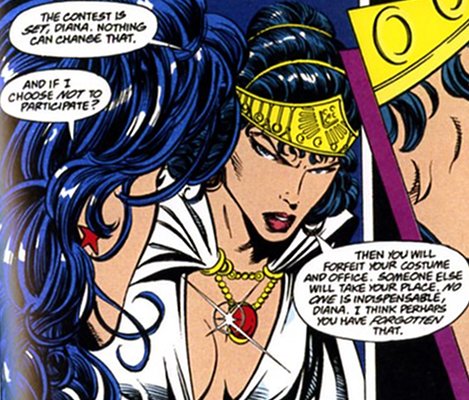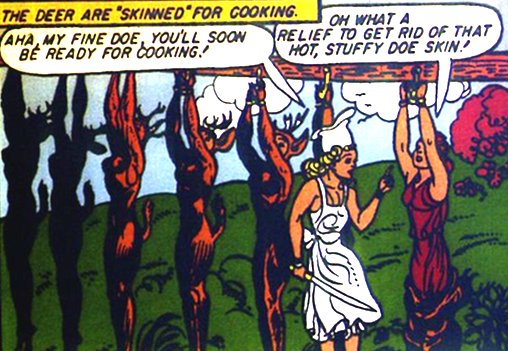Since I’ve been blogging about Wonder Woman again this week, I thought I’d reprint this piece from tcj.com. I’ve included updates from the original post noting comments made by the book’s author. (Update: By the by, this is a review of Wonder Woman: Amazon. Icon. Hero., a coffee table book by Robert Greenberger.)
____________________
Wonder Woman: Amazon. Icon. Hero. Feel your heart stir? Hear those strings swell? Smell the tangy scent of inspiration, with just a little whiff of plastic? Breathe it in! This is your icon, this is your hero! This is your….Wonder Woman!
And who is “your Wonder Woman,” you ask? For many, of course, Wonder Woman is Linda Carter, twirling about in her undies and looking damn good doing it. For kids today, Wonder Woman is mostly the animated version from Justice League Unlimited, a strong, powerful role model who fights for every woman’s right to wear a swimsuit while fighting crime. And then, for some of us, Wonder Woman will always be the original William Marston/Harry G. Peter creation, teaching men to love submission, woman to love woman, and everyone to love the glorious entanglement of bondage and feminism.
All of these Wonder Women were popular. All of them were at least nominally competent at delivering thrills, adventure, strong womanhood and moderately sexy entertainment to girls and boys of various ages. None of these, though, are the Wonder Woman we get in this illustrated coffee-table tribute/history/paean/whatever.
Instead, we get a hodgepodge, mishmash Wonder Woman; a Wonder Woman thrashing about helplessly, but alas, not fetchingly, in the piss-golden strands of indifferent storytelling, sub-par artwork, nonchalant exploitation, and endless, grinding, remorseless continuity. Author Robert Greenberger [Update: with art Director Chris McDonnell] is a wonder himself, choosing illustrations by blindfolding himself and stumbling around DC’s offices after closing hours, while all the while cheerily and randomly retailing the intimate minutiae of idiotic, best-forgotten subplots. Did you know that Wonder Woman’s true-love Trevor Barnes died by containing within himself an entity known as the Shattered God, and then was reincarnated as a healing rainstorm? That WW’s silver bracelets are now called “vambraces”, and are used both for stopping bullets and as orthodontic hardware for creatures of the night? That in an alternate reality Wonder Woman fought Superman and Batman because in that world Supes and Bats were all villainous? That in an alternate reality, Wonder Woman fought Superman and Batman because in that world Supes and Bats were all villainous, and why don’t we tell you about this entirely pedestrian and unimportant story two or three times because everyone likes Superman and Batman more than Wonder Woman and here are pictures of them! And hey, we don’t have anything by Darwyn Cooke, probably the best artist besides Harry Peter to draw WW…but, on the other hand, there’s art by Don Heck, just in case you wondered what Wonder Woman would look like if she were drawn by a Jack Kirby mysteriously and utterly robbed of every scintilla of talent or taste. And look, over there’s some trashy bottom-drawer cheesecake art by Mike Deodato, Jr.!

“Daughter, I am disappointed in you. Look, even my cleavage is angry!”
I do appreciate that Greenberger included some of Harry Peter’s patented space kangaroos, as well as a selection from the brilliantly insane Marston/Peter story in which the Amazons dress up as deer, hunt each other, hogtie each other, and serve each other on a giant plate for dinner in an (ahem) orgy of barely sublimated lesbian masquerade bondage play — all this in a comic directed at an audience of 8-to-10 year olds.
But the points Greenberger gets for including that are somewhat diminished by the fact that he misidentifies the issue number (it’s WW #3, not #6.) In a similar spirit, Greenberger’s thumbnail biography of Marston is both inaccurate (there’s no evidence that Marston’s work on the lie detector had anything to do with the lasso of truth — which was a lasso of obedience in Marston’s stories anyway) and irritatingly coy (golly gee, I wonder why Marston’s wife and his long-time live-in mistress got along so famously! Isn’t that odd? It’s not as if Marston ever suggested that he was at all sexually obsessed with lesbians or anything….)
In short, this is less a sonorous fanfare of tribute to a well-loved and inspirational character than it is an extended and embarrassing fart. Greenberger apparently had no access to, or didn’t want to use, any of the television iterations of WW — not even illustrations from the recent (and visually striking) animated movie direct-to-DVD release are included. So we’re stuck with comic-book versions which, since Marston died and took his genius with him, have consistently oscillated between adequate and — more often — execrable. If you want a tome that thoughtfully explains Wonder Woman’s origin, appeal, and the ins and outs of her troubled history, buy Les Daniels’ Wonder Woman: The Complete History. The only reason anyone would purchase Wonder Woman: Amazon. Hero. Icon., on the other hand, is if they were so obsessed with the character that they had to own every single object graced by her star-spangled derriere. And you know, at $35.00, I can’t help but think that even such a platonic purchaser of all things Wonder would end up feeling ripped off.
__________________
Update: Robert Greenberger sent me an email clarifying his involvement in the project, particularly in image selection. I’ve reproduced the relevant portions below.
All I want to do is correct your colossal misstatement that I had anything to do with the visual selections which were handled by the book’s designer Chris McDonnell. I admit to having made some suggestions, many of which led to art deletions and no additions.
Similarly, I was handed an editorial direction from Universe/Rizzoli focusing solely on the comic and none of the media interpretations. I did the best I could given the limitations of word count and editorial dictate. Sorry it failed to engage you.
Update 2: I should also, I think, apologize to Robert Greenberger. I treated the book as if it was his project, rather than as a more-or-less rote work-for-hire assignment. As a reader, it can be hard to know who is responsible for what, but I certainly should have lambasted the art director Chris McDonnell (whose name is on the frontispiece, if not on the cover.) So, again, my apologies for holding Mr. Greenberger solely responsible for a project that appears to have been botched by a number of individuals — not to mention, of course, by the requisite faceless bureaucracy.

